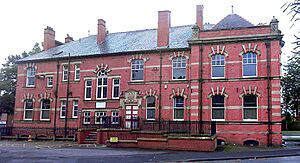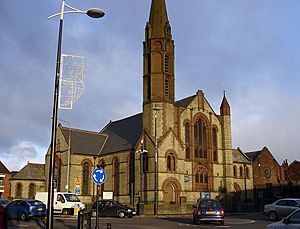Hindley, Greater Manchester facts for kids
Quick facts for kids Hindley |
|
|---|---|
 Hindley Town Hall |
|
| Population | 25,001 |
| OS grid reference | SD6204 |
| Metropolitan borough |
|
| Metropolitan county | |
| Region | |
| Country | England |
| Sovereign state | United Kingdom |
| Post town | WIGAN |
| Postcode district | WN2 |
| Dialling code | 01942 |
| Police | Greater Manchester |
| Fire | Greater Manchester |
| Ambulance | North West |
| EU Parliament | North West England |
| UK Parliament |
|
Hindley is a town in Greater Manchester, England. It is about 3 miles (5 km) east of Wigan. Hindley is part of the larger Greater Manchester Urban Area. In 2011, about 28,000 people lived there.
Contents
Discovering Hindley's Past
What's in a Name?
The name Hindley comes from old English words. Hind means a female deer, and leah means a "clearing" or open space. So, Hindley means a "clearing where deer often visited."
The town's name was first written down as Hindele in 1212. Over time, it changed to "Hindeleye," "Hyndeley," and "Hindelegh." The way we spell it today, Hindley, first appeared in 1479.
Early Days of Hindley
Before 1066, Hindley was one of 15 small areas of the royal manor of Newton. After the Norman conquest, it became part of the Barony of Makerfield.
For a long time, the land was used for farming, raising animals, and had lots of trees. Farmers rented their land from different lords. Records from the late 1600s show that people in Hindley were often independent farmers called Yeomen. They also earned money by spinning and weaving cloth. Hindley was also known for making nails between the 1600s and 1800s.
The Industrial Revolution and Beyond
The first record of a coal mine in Hindley was in 1528. By the late 1800s, there were more than 20 collieries (coal mines) in the area. For example, Ladies Lane Colliery employed over 300 workers in 1896. Coal production was highest just before the First World War.
Cotton making also became very important from the late 1600s to the mid-1900s. Many people wove cloth by hand at home. As the Industrial Revolution grew, bigger factories called mills were built. The first cotton factory was built in 1785.
In the 1800s, Hindley grew a lot. Its population went from 2,300 people in 1811 to 23,000 in 1911. This shows how the town changed from a quiet village to a busy industrial place. However, the economic problems of the 1920s and 1930s hit Hindley hard. Many coal mines and mills closed down. By the time of the Second World War, the population had dropped to 19,000.
Today, the coal mining and cotton spinning industries are gone. Most people who live in Hindley now work in nearby cities like Wigan, Bolton, St Helens, Warrington, Manchester, or Liverpool.
How Hindley is Governed
Hindley used to be a small part of the larger Wigan parish. In 1867, the town started to manage its own local services. Then, in 1894, an Urban District Council was formed with fifteen members to run the area.
Hindley Town Hall, a beautiful building, opened in 1903. The Hindley Urban District Council managed the area until 1974. At that time, Hindley became part of the Metropolitan Borough of Wigan.
Hindley's Geography
Hindley covers an area of about 2,527 acres (10.23 square kilometers). Much of the land is used for pasture (grazing animals). Some very old woodland still exists today in Borsdane Wood. This wood is protected as a Local Nature Reserve.
Hindley town centre is about three miles east of Wigan. It is next to Leigh on its south-east side. The main roads, like the A58 and A577, cross near the town centre.
 |
Aspull | Aspull | Westhoughton |  |
| Ince-in-Makerfield | Atherton | |||
| Ince-in-Makerfield | Abram | Leigh |
Population Changes in Hindley
The number of people living in Hindley changed a lot over time. As industries like coal mining and cotton making grew, so did the town's population.
| Population growth in Hindley since 1901 | ||||||||||
|---|---|---|---|---|---|---|---|---|---|---|
| Year | 1901 | 1911 | 1921 | 1931 | 1939 | 1951 | 1961 | 1981 | 1991 | 2001 |
| Population | 23,504 | 24,100 | 23,563 | 21,632 | 18,993 | 19,415 | 19,396 | 21,493 | 22,581 | 23,457 |
|
Urban District 1901–1971 • Urban Subdivision 1981–2001 |
||||||||||
The population grew a lot in the 1800s, reaching over 24,000 by 1911. But during the 1920s and 1930s, when many factories closed, the population dropped to 19,000. By 2001, it had grown back to around the same number as a century before.
Getting Around Hindley
Public transport in Hindley is managed by Transport for Greater Manchester. You can travel by train from Hindley railway station. Trains go to places like Wigan Wallgate and Manchester. These trains are run by Northern.
Education in Hindley
Hindley and Abram Grammar School was started in 1632. It was originally located in a building called "Lowe Hall." The school moved to Park Road in 1856. At first, students didn't have to pay, but later they paid for subjects like Latin and arithmetic. The school closed in the 1990s, but the building is still used as a teachers' centre.
Mornington High School opened in the early 1960s. In 2006, it was renamed Hindley High School. In 2022, it became Outwood Academy Hindley.
Places of Worship
The first church building in Hindley was a chapel built in 1641. It was for people who followed the Puritan faith. This chapel was later consecrated (made sacred) as All Saints' Church in 1698. The church was rebuilt in 1766 and changed again in 1863.
St Peter's Church was built in 1866. It has a clock tower with bells. Outside the church, there is a war memorial that was revealed in 1922.
Hindley has a long history of different Christian groups. The Methodists built chapels in the 1800s, including St John's Methodist Church in 1868. Other groups like the Baptists and Congregationalists also built churches. The Catholic Church of St. Benedict was built in 1869.
The cemetery on Castle Hill Road opened in 1879. It has different sections for various religious groups. You can also see many gravestones with masonic symbols, showing Hindley's long masonic tradition.
Famous Landmarks
Leyland Library and Museum was built in 1886. It was given to the people of Hindley by Nathaniel Eckersley, following the wishes of John Leyland.
Some old pubs in the town, like The Bird I'th Hand and the Lord Nelson Hotel, date back to the 1700s. The Lord Nelson is a special building, protected as a Grade II listed building.
No.5 Deansgate is a rare old cottage from the 1700s or even earlier. It shows what many homes in Hindley used to look like.
Borsdane Wood is a beautiful natural area. In 1986, it was officially named a Local Nature Reserve.
Notable People from Hindley
Hindley has been home to many interesting people who made a difference.
- John Leyland (1832–1883) owned a mill and was a generous person. He helped pay for additions to the Grammar School and built the Leyland Public Library and Leyland Park.
- Colonel Nathaniel Eckersley (1779–1837) was a military hero who served with the Duke of Wellington. He was also a guardian of the poor in Hindley.
- Nathaniel Eckersley (1815–1892) was a banker, mill owner, and mine owner. He was also a mayor and a Member of Parliament.
- James Carlton Eckersley (1854–1926) followed in his father's footsteps, supporting education and churches.
- Nathaniel Ffarington Eckersley (1857–1935) was a successful mill owner who became one of the biggest cotton spinners in Lancashire. He also served as mayor of Wigan.
- The Pennington family were important industrialists in the 1800s. They owned many mills and employed many people. They also gave a lot of money to build St Peter's Church and improve the town.
Other famous people from Hindley include:
- George Formby, a famous music hall artist and film star.
- John Crank, a mathematician.
- John Stopford, Baron Stopford of Fallowfield, a well-known doctor and Vice-Chancellor of Manchester University.
- Arthur Farrimond, an Olympic runner in 1924.
- Lily Brayton, a Shakespearean actress.
- Many Rugby league players, such as Syd Abram, Paul Deacon, and Shaun Briscoe.
Sports and Fun in Hindley
Hindley has a strong tradition in local sports. The town has amateur teams for football, cricket, and rugby league. Hindley is also known for producing good long-distance runners and cyclists. For example, Arthur Farrimond competed in the 1924 Olympic Games.
A new sports building has been built on Wigan Road. The town also has a swimming pool and a leisure centre run by the local council.
Hindley also has many groups for young people, like two Scout troops, Boys' Brigade, Guides, Brownies, and Army Training Corps. Local schools also offer clubs and activities after school.
Hindley St. Peter's Cricket Club plays in several leagues. They won the Manchester Association Twenty20 tournament in 2007 and the Premier League championship in 2008 and 2009.
Hindley Amateur Rugby League Club has teams for all ages, from seven-year-olds to adults. It is one of the fastest-growing clubs in the northwest. Many players from this club have gone on to play professionally, including:
- John Clarke – Warrington Wolves
- Paul Deacon – Wigan Warriors
- Thomas Makinson – St Helens
Hindley Junior and Hindley Town football clubs also have teams for all ages, from under six to under 16.
See also
 In Spanish: Hindley para niños
In Spanish: Hindley para niños







